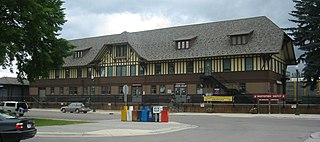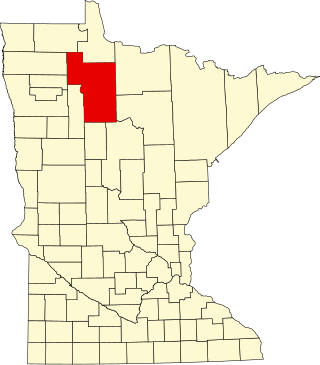
The Stone Arch Bridge is a former railroad bridge crossing the Mississippi River at Saint Anthony Falls in downtown Minneapolis, Minnesota. It is the only arched bridge made of stone on the entire Mississippi River. It is the second oldest bridge on the river next to Eads Bridge. The bridge was built to connect the railway system to the new Union Depot, which at that time was planned to be built between Hennepin Avenue and Nicollet Avenue. The bridge was completed in 1883, costing $650,000 at the time. 117 Portland Avenue is the general address of the historic complex.

Whitefish station is a stop on Amtrak's Empire Builder in Whitefish, Montana. In addition to the Empire Builder, a once-daily Greyhound Lines bus service also links the station to Kalispell and Missoula. A car rental agency operates a window within the station. The station and parking lot are owned by the Stumptown Historical Society. BNSF Railway leases office space on the upper floors of the station and owns the platform and track.

The Centralia Union Depot is an Amtrak train station in Centralia, Washington, United States. It is served by the Cascades and Coast Starlight trains.

Endion station is a former train station in Duluth, Minnesota, United States. It was built in 1899 to serve the Endion neighborhood but was relocated to Canal Park in 1986 to make way for expansion of Interstate 35. Passenger service through the station had ceased in 1961 and freight service in 1978.

Princeton station in Princeton, Minnesota, United States, is a former passenger and freight depot on the Great Northern Railway. The building is a combination of Queen Anne and Jacobean architectural styles, built of local brick with sandstone trim. It was listed on the National Register of Historic Places in 1977 as the Great Northern Depot.

The Atchison, Topeka and Santa Fe Passenger and Freight Complex is a nationally recognized historic district located in Fort Madison, Iowa, United States. It was listed on the National Register of Historic Places in 1992. At the time of its nomination it contained three resources, all of which are contributing buildings. The buildings were constructed over a 24-year time period, and reflect the styles that were popular when they were built. The facility currently houses a local history museum, and after renovations a portion of it was converted back to a passenger train depot for Amtrak, which opened on December 15, 2021.
The Great Northern Depot or Great Northern Passenger Depot may refer to:

The Beltrami County Courthouse is a historic government building in Bemidji, Minnesota, United States. It was erected in 1902 as the seat of government for Beltrami County. District court functions relocated in 1974 to the newly completed Beltrami County Judicial Center immediately to the southwest, and the historic courthouse has been remodeled to house government offices. The old courthouse was listed on the National Register of Historic Places in 1988 for its state-level significance in the themes of architecture and politics/government. It was nominated for its status in Beltrami County as its long-serving center government and as its most prominent example of public architecture and Beaux-Arts style.

The Chicago, Milwaukee, St. Paul and Pacific Railroad Depot and Lunchroom are two buildings located in Wells, Minnesota, and built by the Chicago, Milwaukee, St. Paul and Pacific Railroad in 1903.

Wayzata station is a historic train depot in Wayzata, Minnesota, United States. Constructed and operated by the Great Northern Railway, the station was in service from 1906 until 1971. The depot is positioned along Lake Minnetonka in downtown Wayzata with steps leading down to the lakeshore. Although no longer transporting passenger trains, the BNSF Railway line going through Wayzata is still active today.

Thief River Falls station is a historic train station in Thief River Falls, Minnesota. The station was built in 1913 to replace an earlier station and saw passenger traffic until 1967. It was listed on the National Register of Historic Places in 1995 as the Minneapolis, St. Paul and Sault Ste. Marie Railroad Depot and now serves as the Thief River Falls city hall.

The Frisco Depot and adjacent Antlers Spring are historic sites in Antlers, Oklahoma, United States. The sites are a part of the National Register of Historic Places, in which they appear as a single entry.

This is a list of the National Register of Historic Places listings in Beltrami County, Minnesota. This is intended to be a complete list of the properties and districts on the National Register of Historic Places in Beltrami County, Minnesota, United States. The locations of National Register properties and districts for which the latitude and longitude coordinates are included below, may be seen in an online map.

The Chicago and Northwestern Railroad Depot is a railroad station located between Suffolk and Lowell Streets in Ironwood, Michigan. It was listed on the National Register of Historic Places in 1985.

The Nevada–California–Oregon Railway Passenger Station is a historic train station in Lakeview, Oregon, United States. It was built in 1912 by contractor I. A. Underwood from plans by architect Frederic DeLongchamps. It was the northern terminus of the Nevada–California–Oregon Railway. The Southern Pacific Railroad company owned and operated the depot from 1928 until 1975, when it was closed. Since 1978, the building has been used as a law office and later a private residence. Because of its importance to local history, the depot was listed on the National Register of Historic Places in 1983.

The Bemidji Carnegie Library is a former library building in Bemidji, Minnesota, United States. It was built as a Carnegie library in 1909 and housed the city's public library until 1961. It was listed on the National Register of Historic Places in 1980 for its local significance in the themes of architecture and education. It was nominated for being a well-preserved example of a Carnegie library and of public Neoclassical architecture.

The Santa Fe Passenger and Freight Depot is a former Santa Fe Railroad station located at 150 Central Valley Highway in Shafter, in the southern San Joaquin Valley within Kern County, California.

The Missoula station in Missoula, Montana, was built by the Northern Pacific Railway in 1901. The current structure is the third depot built in Missoula by the Northern Pacific, which reached Missoula in 1883. It was listed on the National Register of Historic Places in 1985, as the Northern Pacific Railroad Depot.

The Greenback Depot is a former railroad station located in Greenback, Tennessee, United States. Built in 1914 by the Louisville and Nashville Railroad (L&N), the depot served rail freight and passengers traveling in and out of the Greenback area until 1954. Restored for use as a community events center by Ronald Edmondson in the early 2010s, the depot was listed on the National Register of Historic Places in 2013 in recognition of its role in the area's transportation history.

Chesterton is a disused train station in Chesterton, Indiana. The current depot replaced a wooden structure built in 1852 for the Northern Indiana and Chicago Railroad, a predecessor road of the Lake Shore and Michigan Southern Railway, that burned down in 1913. It was rebuilt in 1914 as a brick structure. By 1914, Cornelius Vanderbilt of the New York Central and Hudson River Railroad held a majority interest in the Lake Shore and Michigan Southern Railway. The Southern Railways trackage provided an ideal extension of the New York Central from Buffalo to Chicago. On December 22, 1914, the New York Central and Hudson River Railroad merged with the Lake Shore and Michigan Southern Railway to form a new New York Central Railroad.























